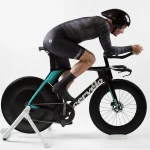Indoor Time Trailing
Indoor Racing on Trainers

Computrainer indoor time trials are back! I joined the fun at Fastplits last week entering Boston Triathlon Team’s indoor time trial. While smart trainers like Wahoo Kickr’s and indoor cycling apps like Zwift and Rouvy have taken over indoor cycling, it seems somebody forgot to tell this crew. Nothing compares to the nostalgia of training and suffering in person then having a beer afterward and chatting and catching up with fellow triathletes and cyclists.
A lot of memories came back to me about computrainer and some of the mystery surrounding the physics and the way these events play out. I could also go on about Zwift’s physics so no better time than now to talk about both.
I found computrainer indoor time trials favored me many years ago and sought out to learn why. It wasn’t just me, many discussions with triathletes and cyclists that led to the same conclusions – these things seem to be more about total watts regardless of body weight. In the real world, total watts only gets you so far as when the grade goes up the lighter riders watts/kg ratios wins. On the flats just making watts may favor larger riders, but they’re also less aerodynamic since they’re larger so in the end it’s watts/CdA ratio (a data geek way of saying how many watts you make divided by your aerodynamic factor decides what speed you go).
Weight Bias
After some amount of time crunching numbers in whatever computrainer ride files I could gather I found the culprit. Computrainer assumed the same CdA value regardless of your body weight. I may be dating myself 15 years with this study, but I still have the spreadsheets saved. These were also the pre-strava and pre-garmin days where I was pulling files from SRM and Powertap computers via download cables, running them across a version of a computrainer course I’d made in excel to try to pry out CdA values. Think of an early day version of BestBikeSplit.com, but that took weeks to create a course model and was less accurate. You could imagine how happy I was when years later somebody figured out a way to do this in seconds! The trouble with assuming the same CdA value for every rider is the heavier riders benefit and the lighter riders get penalized. It’s not much, but is a difference maker compared to real life cycling. It really shows up riding downhill when larger riders have gravity pulling them down even faster since they have the same drag as their lighter competitors in more of a “kg/CdA” factor where the heavier you are and/or the more aero you are the faster you descend. I just made that kg/CdA ratio up so I don’t recommend trying to use it with your friends.
Year’s later Zwift was born and took indoor cycling to a new level never seen before. Zwift physics are also different from the real world and to this day I feel the Zwift engineers had an axe to grind with Computrainer physics. In Zwift we go straight from a computrainer world of physics that favor larger riders, skip right past real world cycling physics, and arrive in a world of physics that benefit smaller riders. Let’s clarify that, Zwift physics don’t favor lighter riders, but shorter riders. My skepticism of the Zwift physics started during the Covid lockdown.
My Daughter is Faster than Me
I had a couple teenage daughters riding on Zwift as well which was fun as we all could talk about it. My then 16-year old said she was entering the “Chasing Cancellara time trial” and while I wouldn’t normally subject myself to that particular brand of solo-torture, and haven’t since, I joined too. She went in the evening, and I went the following morning. We both won the cool jersey, and talked about it which is what mattered. I was a little surprised how close our times were and more specifically how slow my average speed was for the power I put out on what looked like a cool decked out TT bike on the screen. On the other hand, my daughter went impressively fast for 160 watts. It was time to crack the code on what was causing this difference.
AHA!!
It was easy to select the flat Tempus Fugit Zwift course in BestBikeSplit and within minutes I was playing around with CdA values to replicate both our times. Within minutes I arrived at CdA values after what would have taken weeks and months back in the day. Actually this isn’t entirely true as I noticed a 15 second gap in her file where there was no power or cadence so wondered what happened. Maybe it was an annoying power drop. I asked her that night if she remembered. “Oh yeah, I had to stop to take my pajama bottoms off”… Fortunately all was not lost as it was the pancake flat Tempus Fugit course and the solution involved just taking her average before and after the gap which gave the same result. Her CdA came out to 0.20 and mine came out to 0.28. She’s 5’4” and I’m 6’3”. On the surface this passes the sniff test, as taller riders expose more surface area to the wind so should have a higher CdA. If we do a back of the envelope check it’s believable that a 5’4” female cyclist has a CdA around 0.20, and in fact it wasn’t long ago that pro women time trialists were arriving around that number. Not bad for a recreational teenage cyclist in pajama bottoms. On the other hand, a 6’3” cyclist with a CdA of 0.28 isn’t going to compete as well. It’s in the ballpark, and there are many fast triathletes and cyclists around that number but if I were to assign a comparable value to a 6’3 rider given a 0.20 value for a 5’4” rider it was be closer to 0.25. There are too many details to put an exact CdA adjustment based on height as taller riders are bent over so not exposing all their height, but at the same time they’re likely wider too. It’s just a training tool so we need to pick something.
Zwift Penalizes the Taller Riders
This however isn’t my real issue with Zwift physics. It’s the drafting and more specifically the fact that taller riders see the same proportionately higher CdA value while drafting. This is where this small disadvantage becomes a bigger one. As speeds pick up in larger Zwift groups I find myself near my threshold just to sit in. The faster the ride, the harder I feel it is to stay with the group. How could this be when in the real world with a big group it’s almost effortless to sit in at high speeds? The churning effect on the front of Zwift groups (basically riders constantly riding through each other allows the front to go faster than it would in real life) leads to faster speeds and with faster speeds comes higher amounts of drag. When you’re getting slightly over-penalized for height, this becomes an exponentially over-penalized amount.
I actually feel this is one of the biggest reasons I enjoy Zwift. It’s just a training tool and one that allows me to ride in sweet spot or near my threshold for long amounts of time through motivation just to stay with a group. I didn’t even touch on some of the Zwift challenges that impact everybody like the draft benefit completely vanishing when you’re a short distance off the back of a group. I understand this is deliberate design to keep riders in groups for more of a social feel which I completely understand and even prefer. It’s less enjoyable when you’re that rider a couple bike lengths off the back frantically sprinting out of the saddle to catch back on only to watch the group rider away effortlessly. We all deal with these challenges together though.
Yay Zwift
After all this criticism of Zwift physics based on years of riding, there has been a recent Zwift update that has reduced the churn on the front of groups and slowed the average speeds significantly. I do find it’s easier to sit in now and even when riding solo I don’t seem to lose time to the group as quickly as I used to. I’m sticking to my guns that they still over penalize height, but just not as bad now 😊
If you need me you can find me riding on a Zwift group ride every morning, even in the summer! The new indoor cycling world is amazing!









